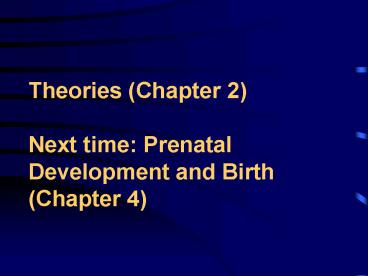Theories Chapter 2 Next time: Prenatal Development and Birth Chapter 4 - PowerPoint PPT Presentation
1 / 32
Title:
Theories Chapter 2 Next time: Prenatal Development and Birth Chapter 4
Description:
in the New Physics Building, room ... which children interpret new experiences by incorporating them ... Species-wide commonalities. Evolution. General ... – PowerPoint PPT presentation
Number of Views:120
Avg rating:3.0/5.0
Title: Theories Chapter 2 Next time: Prenatal Development and Birth Chapter 4
1
Theories (Chapter 2)Next time Prenatal
Development and Birth (Chapter 4)
2
Do you like BRAINS?! The NEUROSCIENCE CLUB
will be having its first meeting on Tuesday,
Sept. 9th in the New Physics Building, room
1002 at 700 pm Featuring Dr. Jeffery Kleim
speaking on Brain Plasticity Open to ANYONE, not
just science majors! Learn about the research
being done here at UF and how you can
participate! Share your own research with your
peers and create lasting contacts with students,
faculty, and potential employers or professional
schools! Opportunities to hear professionals in
the field explain their own research AND MORE!
Officer positions and volunteer opportunities
also available. More information at
www.freewebs.com/neuroscienceclub or check out
Neuroscience Club on facebook Hope to see you
there!!! p.s. There will be no actual brains
lying around at the meetings. Sorry for the false
advertising.
3
Theories (Chapter 2)Next time Prenatal
Development and Birth (Chapter 4)
4
Theories
- Psychoanalytic
- Learning Theory
- Cognitive-Developmental
- Ethological/Evolutionary
- Ecological Systems (Bronfenbrenner)
5
Cognitive-Developmental
6
Cognitive-Developmental
- Piaget
- Vygotsky/Sociocultural
- Information Processing
7
Piaget (1896-1980)
8
Piaget
- Trained in
- philosophy, especially epistemology
- natural sciences, especially biology
9
Piagetian Emphases
- Commonalities
- Qualitative Change
- Stages
10
Table 2-3, p. 62
11
Piagetian Concepts
- Organization (p. 245)
- Adaptation (p. 245)
- Assimilation (p. 61)
- Accommodation (p. 61)
12
Assimilation (p. 61) Piagets term for the
process by which children interpret new
experiences by incorporating them into their
existing schemes
13
Accommodation (p. 61) Piagets term for the
process by which children modify their existing
schemes in order to incorporate or adapt to new
experiences
14
General Issues Piagetian Theory
- Normative-Idiographic Primarily normative
- Nature-Nurture Both important--an interactionist
theory - Active-Passive Strong emphasis on activity
- Holistic-Modular Strongly holistic
- Continuity-Discontinuity Both emphasized
15
Theories
- Psychoanalytic
- Learning Theory
- Cognitive-Developmental
- Ethological/Evolutionary
- Ecological Systems
16
Ethological/EvolutionaryLorenzTinbergenBowlby
17
Ethological Emphases
18
Ethological Emphases
- Comparative study
19
Ethological Emphases
- Comparative study
- Naturalistic study
20
Ethological Emphases
- Comparative study
- Naturalistic study
- Biological bases for behavior
21
Ethological Emphases
- Comparative study
- Naturalistic study
- Biological bases for behavior
- Learning predispositions (e.g., imprinting)
22
Imprinting (pp. 65, 440) An innate or
instinctual form of learning in which the young
of certain species will follow and become
attached to moving objects (usually their mothers)
23
p. 65
24
Ethological Emphases
- Comparative study
- Naturalistic study
- Biological bases for behavior
- Learning predispositions (e.g., imprinting)
- Species-wide commonalities
25
Ethological Emphases
- Comparative study
- Naturalistic study
- Biological bases for behavior
- Learning predispositions (e.g., imprinting)
- Species-wide commonalities
- Evolution
26
General Issues Ethological
- Nature-Nurture Emphasis on nature
- Normative-Idiographic Primarily normative
- Continuity-Discontinuity Both emphasized
27
Theories
- Psychoanalytic
- Learning Theory
- Cognitive-Developmental
- Ethological/Evolutionary
- Ecological Systems (Bronfenbrenner)
28
Fig. 2-5, p. 70
29
Microsystem (p. 69) The immediate settings
(including role relationships and activities)
that the person actually encounters the
innermost of Bronfenbrenners environmental
layers or contexts
30
Fig. 2-5, p. 70
31
Mesosystem (p. 69)Exosystem (p. 70)Macrosystem
(p. 70)Chronosystem (p. 71)
32
Fig. 2-5, p. 70






























